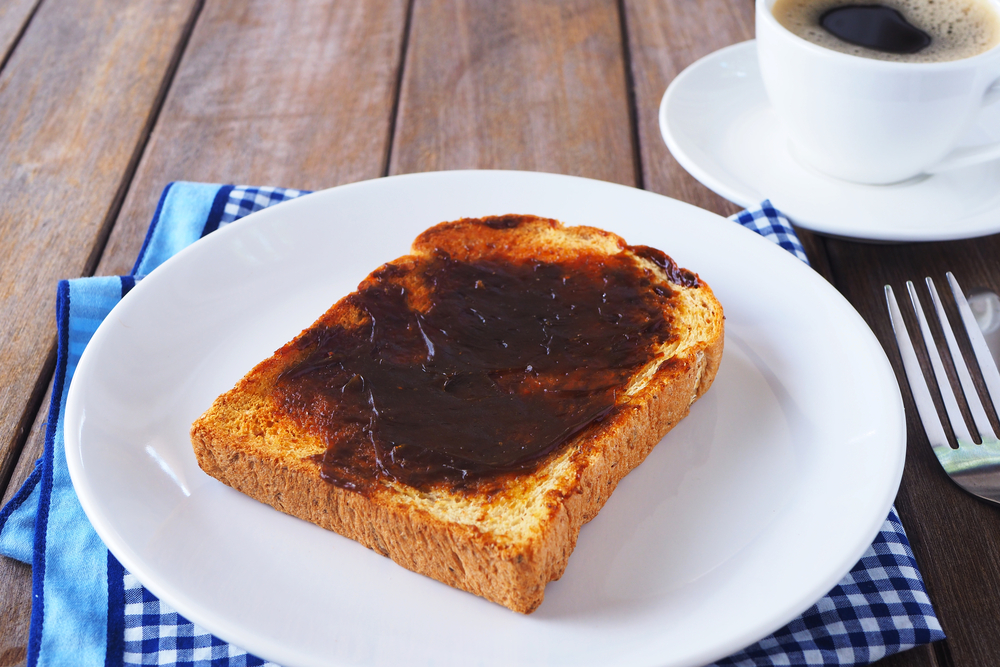New research has found that that people who consume yeast extracts and tomato-based sauces have higher median sodium intakes, but also receive important nutrients from these products.
Salt intakes in Australia are excessive. In adults, the average daily sodium intake, quantified by meta-analysis of 26 studies that measured 24-hour urinary sodium, is 3800 mg (equivalent to 9.6 g or about two teaspoons of salt). By comparison the suggested dietary target (SDT) for sodium is 2000 mg per day (5 g salt or about one teaspoon).
Cutting down on salt is worth the effort because salt increases the risk of developing hypertension (here). In Australia, currently one in three adults have hypertension and of those in whom it has been recognised, less than half have blood pressure that is well controlled. High blood pressure is attributed to 65% of hypertensive heart disease burden, 43% for coronary heart disease, 41% for stroke and 38% for chronic kidney disease in Australia (here).
Where does our salt come from?
Most of our sodium comes from nutrient-rich core foods, including bread. This means that manufacturers need to reduce the salt added into these products. For individuals, it means checking food labels to find products with the lowest amount of sodium per 100 g of product. Choose salt-reduced and low salt products. Sometimes you need to swap to a different food, like chicken breast instead of processed meat. More than a third (38%) of dietary sodium comes from energy-dense, nutrient-poor (EDNP), discretionary food (here). This includes processed foods purchased at the supermarket, especially dried foods that you just add hot water to such as soup, rice and pasta mixes or meals, and canned foods.
Foods eaten away from home can be salty. Just under a third (28%) of dietary sodium within this category comes from restaurant, takeaway and fast food (here). Despite making up less than 15% of all meals (here), over half of our sodium intakes come from store-bought foods (here).
Within the home, 61% of adults report adding salt during cooking and 32% add it at the table (here).
To shift Australian salt intakes to meet the SDT, we would need Australians to reduce their current intakes by about half. A comprehensive reformulation strategy is needed to lower the amount of sodium in our diet, including processed foods purchased in supermarkets, as well as foods served in restaurants, pubs, clubs and takeaway.

Our research
Yeast extract spreads and tomato-based sauces (ie, ketchup) are consumed regularly by many Australians. Because they can be high in salt, we wanted to find out whether commonly used condiments (eg, Vegemite™) and tomato sauce (eg, ketchup and pasta sauce) were adding to our excessive sodium intakes (see our research). However, we also wanted to see whether they made an important contribution to intakes of other essential nutrients, such as B vitamins. If they did, that would affect the dietary advice given to people with regard to which foods to reduce and which to eat more of to boost vitamin and mineral intakes.
We analysed the national dietary survey data to find out how much these condiments contributed to nutrient intakes. We used dietary data from the Australian National Nutrition Survey that had measured food intakes in over 12 000 Australians aged two years or older and checked the 24-hour recalls for consumption of any yeast extract spreads (VegemiteTM, Promite®, MarmiteTM, MightyMite, Bonox) or tomato-based sauces (tomato or barbeque sauce, commercial tomato-based pasta sauces, taco sauce, salsa).
We found that one in five people (19.6%) had eaten either a yeast extract spread or tomato-based sauce, of those, 11.7% had consumed yeast extracts, 6.7% tomato-based sauces and 1.2% had consumed both in the previous 24-hour period. This was less than we expected. Most people consumed these condiments and sauces at breakfast time. Yeast extracts were mostly eaten with bread, whereas tomato-based sauces were more commonly eaten with meat products, savory pastries and fried foods (eg, bacon, pies, sausage rolls, and fish and chips). Surprisingly, the tomato-based pasta sauces were not eaten as often as we expected. For the highest consumers, sodium intakes from yeast extracts contributed approximately 14% and tomato-based sauces about 12% of their total sodium intakes. Overall, we found that people who did consume yeast extracts and tomato-based sauces had higher median sodium intakes (2400 mg/day).
We weren’t surprised to find that people with higher intakes of yeast extract spreads in the previous 24 hours had higher sodium intakes, but we also found they had higher intakes of important nutrients, including the minerals potassium, iron, zinc, iodine and magnesium, and B vitamins, thiamine, riboflavin, niacin and folate. Results were similar for tomato-based sauces. People with higher intakes did have higher sodium intakes, but also higher intake of potassium, iron, zinc, iodine, magnesium, riboflavin, niacin, folate and b-carotene.
Keep in mind that this survey reports population average data based on one-day estimates of dietary intake, so there will be some individuals whose usual sodium intakes are either higher or lower than average. In addition, if condiments are added to foods that are energy-dense and nutrient-poor, such as pies, hot chips and other takeaway foods, then intakes of saturated fat will be higher and dietary fibre lower.
Box 1 provides a list of food sources of these key nutrients that are not high in sodium.
| Nutrient | Rich food sources |
| Potassium | Apples, oranges, bananas, apricots, avocados, leafy green vegetables, tomatoes, cucumbers, zucchini, eggplant, pumpkin, carrots, potatoes, sweet potatoes, legumes, milk, yoghurt, red meat, chicken, fish |
| Iodine | All store-bought bread* (except organic) is made with iodised salt, seafood, seaweed, eggs, green leafy vegetables |
| Iron | Red meat, chicken and fish. Note that non-haemiron is found in driedbeans and lentils and iron-fortified breakfast cereals* |
| Zinc | Red meat, eggs, seafood, oyster nuts, tofu, legumes, wheat germ, wholegrain foods |
| Magnesium | Tofu, almonds, sunflower seeds, pumpkin seeds, sesame seeds, spinach and soy beans |
| Niacin | Lean meats, milk, eggs, wholegrain breads and cereals*, nuts, leafy green vegetables and all protein-containing foods |
| Thiamine | Wholemeal cereal grains, seeds, legumes, wheatgerm, watermelon, vegemite, yeast and pork |
| Riboflavin | Milk, yoghurt, cottage cheese, wholegrain breads and cereals*, egg white, leafy green vegetables and red meat |
| Folate | Green leafy vegetables, legumes, seeds, poultry, eggs, cereals and citrus fruits. Many breads* and breakfast cereals* are fortified with folate in Australia |
| b-Carotene | Dark yellow, orange and dark green vegetables. Increase intake of carrots, sweet potato and pumpkin, spinach and broccoli |
* Check the sodium content and choose products with the lowest amount, see Box 2.
Implications for GPs
Everyone needs to support people to improve their diet-related health. This includes food companies who need to reformulate their products to lower the sodium content. It also means that clinicians take opportunities to direct clients to evidence-based information on food and nutrition and refer on to Accredited Practising Dietitians when clients need medical nutrition therapy. Our No Money No Time website provides access to free nutrition information and resources, including recipes and fact sheets, for the public.
Given that high intakes of sodium are common, people should be encouraged to follow the recommendation in Box 2, particularly as hypertension is so common among Australian adults.
| Recommendations Use our No Money No Time resources to help. They are hyperlinked below. |
|
| 1 | Eat a bigger variety of nutritious foods, including wholegrains, vegetables, fruit, lean sources of protein, legumes and dairy products. |
| 2 | Increase intake of food rich in potassium, such as vegetables, fruit, and dairy foods, because potassium helps to counter the blood pressure raising effects of sodium. |
| 3 | Avoid adding salt when cooking or at the table. Replacing table salt with a potassium-enriched product. Try some different herbs and spices to help you add extra flavor. |
| 4 | Choose lower salt or salt-reduced varieties of processed foods. Low salt is defined as having less than 120 mg sodium per 100 g of the product, while salt-reduced means it contain about 25% less sodium compared to usual. Here is a link to our food product label reading ready decoder. |
| 5 | When selecting convenience meals at the supermarket, select the healthiest options. |
| 6 | When eating food away from home ask for no salt to be added and choose the healthiest options you can. |
Laureate Professor Clare Collins is a Professor in Nutrition and Dietetics at the University of Newcastle, a National Health and Medical Research Council Leadership Research Fellow, and Director of the Food and Nutrition Research Program for Hunter Medical Research Institute.
Dr Erin Clarke is an Accredited Practising Dietitian and Postdoctoral Fellow in nutrition and metabolic health at the University of Newcastle.
Associate Professor Tamara Bucher leads a food and nutrition research program at the University of Newcastle to support access to better, healthier food options.
The statements or opinions expressed in this article reflect the views of the authors and do not necessarily represent the official policy of the AMA, the MJA or InSight+ unless so stated.
Subscribe to the free InSight+ weekly newsletter here. It is available to all readers, not just registered medical practitioners.
If you would like to submit an article for consideration, send a Word version to mjainsight-editor@ampco.com.au.

 more_vert
more_vert
In your Box 1 in the comment on iodine rich foods you have omitted dairy milk and dairy products, which next to bread are the major source(s) of iodine in the Austraian diet.
When talking about the use of discretionary salt, of course the least amount possible is the best, but one should add the rider that any discretionary household salt salt should be iodised salt.